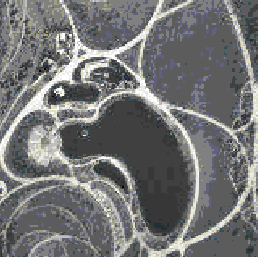

With two stumbling blocks removed (namely rapid synchronization with local coupling, and rapid desynchronization), oscillator networks can finally be used to address real image segmentation. Wang and Terman (in press) applied LEGION to segmenting gray-level images, and reported very promising results. For gray-level images, each pixel corresponds to an oscillator, and two pixels establish a permanent connection with the weight that is reciprocal to the difference of their pixel values. To speed up computer simulation, they abstracted a computer algorithm which strictly followed the dynamics of LEGION. As an example, Figure 7a shows one gray-level image to be processed. Figure 7b shows the result of segmentation. The entire image is segmented into 17 regions, each of which corresponds to a different density in the figure, which indicates the phases of oscillators. In the simulation, different segments rapidly "popped out" from the image alternately in time, as shown similarly in Figure 6. The segments are put together in Figure 7b merely for illustration purposes. As can be seen from Figure 7b, almost all major regions were segmented, including the central lake, major roads, and various fields. Notice that the island in the central lake was not grouped with the lake, and that another island in the lake to the upper left of the central lake was also segmented from its surrounding lake. The black scattered regions in the figure represent the background that always remains inactive (see Wang and Terman, in press, for more details).
 |
 |
| |
|
We have tested the algorithm using other images as well, including MRI images from the medical domain. The network produces results of similar quality as in Figure 7. To our knowledge, LEGION represents the only neural network model that can demonstrate segmentation of real images. Compared to traditional techniques for image segmentation, this oscillatory correlation approach offers many unique advantages. The dynamics is inherently parallel. The remarkable simplicity of this approach makes the network particularly feasible for VLSI implementation. Furthermore, continuous-time dynamics allows real time processing.